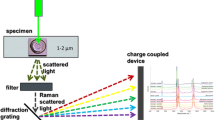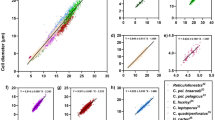Abstract
Cotton blue was added to sediment samples at least 2 h before chironomid head capsules were picked under a binocular microscope and mounted on slides for identification. The use of stain greatly increased the visibility of chironomid head capsules during picking and enhanced the contrast of various parts of the head capsules (pores, ventromental plates, striations on ventromental plates), which could aid identification. In the seven samples studied, there was no significant difference between the percentages of taxa found in stained and unstained samples. The number of taxa were also similar in stained and unstained samples. This method allowed samples to be picked faster.




Similar content being viewed by others
References
Brooks SJ (2006) Fossil midges (Diptera: Chironomidae) as palaeoclimatic indicators for the Eurasian region. Quat Sci Rev 25:1894–1910
Brooks SJ, Langdon PG, Heiri O (2007) The Identification and Use of Palaearctic Chironomidae Larvae in Palaeoecology. QRA Technical Guide No. 10. Quaternary Research Association, 276 pp
Iovino AJ (1975) Extant chironomid larval populations and the representativeness and nature of their remains in lake sediments. Indiana University, Bloomington
Langdon P, Ruiz Z, Wynne S, Sayer C, Davidson T (2010) Ecological influences on larval chironomid communities in shallow lakes: implications for palaeolimnological interpretations. Freshw Biol 55:531–545
Larocque I, Rolland N (2006) Le guide visuel des chironomids sub-fossiles, du Québec à l’île d’Ellesmere, INRS rapport de Recherche R-900, ISBN 2-89146-430-3
Larocque I, Velle G, Rolland N (2010) Effect of removing small (<150 μm) chironomids on inferring temperature in cold lakes. J Paleolimnol 44:709–719
Leck A (1999) Preparation of lactophenol cotton blue slide mounts. Community Eye Health 12:24
Rolland N, Larocque I (2007) The efficiency of kerosene flotation for extraction of chironomids head capsules from lake sediment samples. J Paleolimnol 37:565–572
Velle G, Larocque I (2008) Assessing chironomid head capsule concentrations in sediment using exotic markers. J Paleolimnol 40:165–177
Verschuren D, Eggermont H (2007) Sieve mesh size and quantitative chironomid paleoclimatology. J Paleolimnol 38:329–345
Walker IR (2001) Midges: Chironomidae and related Diptera. In: Smol JP, Birks HJB, Last WM (eds) Tracking environmental change using lake sediments. Volume 4 zoological indicators. Kluwer Academic Publishers, Dordrecht, pp 43–66
Walker IR, Cwynar LC (2006) Midges and palaeotemperature reconstruction–the North American experience. Quat Sci Rev 25:1911–1925
Author information
Authors and Affiliations
Corresponding author
Rights and permissions
About this article
Cite this article
Larocque-Tobler, I., Oberli, F. The use of cotton blue stain to improve the efficiency of picking and identifying chironomid head capsules. J Paleolimnol 45, 121–125 (2011). https://doi.org/10.1007/s10933-010-9476-7
Received:
Accepted:
Published:
Issue Date:
DOI: https://doi.org/10.1007/s10933-010-9476-7




